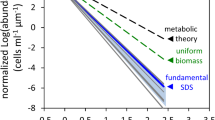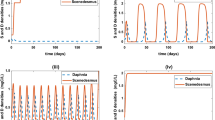Abstract
Phytoplankton stoichiometry or nutrient content has been shown to vary in a number of dimensions (species, condition, time, space), but the heterogeneity within a species at a given time and location, and the underlying mechanisms and importance have not been explored. There are a number of mechanisms that can create intraspecific heterogeneity, and theory suggests it can affect the population growth rate. We studied heterogeneity in P content of the freshwater diatom Cyclotella meneghiniana in the Charles River in Boston. Single-cell observations using synchrotron-based X-ray fluorescence show that the nutrient status varies from P-starved to P-replete. We simulate individual cells using an agent-based model that accounts for a number of mechanisms that can create heterogeneity, including surface area–based uptake, mortality differentiation, stochastic biological variability in states and behavior, macroscale mixing, and microscale nutrient patch encounter. By performing a number of simulations with various mechanisms turned on/off and comparing to data, we conclude that the heterogeneity is mostly due to microscale patchiness (85%). We explore the importance of accounting for heterogeneity in models by performing a simulation with the growth rate based on the population-average internal nutrient, as is done in conventional population-level models. This shows that ignoring heterogeneity increases the population growth rate by a factor of 1.47. To account for different heterogeneity in the laboratory and field, population-level ecosystem models should reduce maximum growth rates. The magnitude of this correction depends on local conditions, and in our case, it is a factor of 0.72.








Similar content being viewed by others
References
Bidle KD, Falkowski PG (2004) Cell death in planktonic, photosynthetic microorganisms. Nature Rev Microbiol 2:643–655
Blumberg AF, Mellor GL (1987) A description of a three-dimensional coastal ocean circulation model. In: Heaps N (ed.) Three-dimensional coastal ocean models. American Geophysical Union, Washington, D.C., pp. 1–16
Brussaard CPD, Noordeloos AAM, Riegman R (1997) Autolysis kinetics of the marine diatom Ditylum brightwellii (Bacillariophyceae) under nitrogen and phosphorus limitation and starvation. J Phycol 33:980–987
Brzezinski MA (1992) Cell-cycle effects on the kinetics of silicic acid uptake and resource competition among diatoms. J Plankton Res 14:1511–1539
Butler NM, Suttle CA, Neill WE (1989) Discrimination by freshwater zooplankton between single algal cells differing in nutritional status. Oecologia 78:368–372
Chapra SC (1997) Surface water-quality modeling. McGraw-Hill, Boston
Chisholm SW (1981) Temporal patterns of cell division in unicellular algae. Can Bull Fish Aquat Sci 210:150–181
Di Toro DM, Fitzpatrick JJ, Thomann RV (1983) Water quality analysis simulation program (WASP) and model verification program (MVP)-documentation. Hydroscience
Droop MR (1975) The nutrient status of algal cells in batch culture. J Mar Biol Assoc UK 55:541–555
Edlund MB, Stoermer EF (1997) Ecological, evolutionary, and systematic significance of diatom life histories. J Phycol 33:897–918
El-Bestawy E, Bellinger EG, Sigee DC (1996) Elemental composition of phytoplankton in a subtropical lake: X-ray microanalytical studies on the dominant algae Spirulina platensis (Cyanophyta) and Cyclotella meneghiniana (Bacillariophyceae). Eur J Phycol 31:157–166
Falkowski PG (2000) Rationalizing elemental ratios in unicellular algae. J Phycol 36:3–6
Fisher TR, Lean DRS (1992) Interpretation of radiophosphate dynamics in lake waters. Can J Fish Aquat Sci 49:252–258
Gisselson L-A, Graneli E, Pallon J (2001) Variation in cellular nutrient status within a population of Dinophysis norvegica (Dinophyceae) growing in situ: Single-cell elemental analysis by use of a nuclear microprobe. Limnol Oceanogr 46:1237–1242
Healey FP, Hendzel LL (1979) Indicators of phosphorus and nitrogen deficiency in five algae in culture. J Fish Res Board Can 36:1364–1369
Heldal M, Scanlan DJ, Norland S, Thingstad F, Mann NH (2003) Elemental composition of single cells of various strains of marine Prochlorococcus and Synechococcus using X-ray microanalysis. Limnol Oceanogr 48:1732–1743
Hellweger FL, Bucci V (2009) A bunch of tiny individuals: Individual-based modeling for microbes (review paper). Ecol Model 220:8–22
Hellweger FL, Kianirad E (2007) Accounting for intra-population variability in biogeochemical models using agent-based methods. Environ Sci Technol 41:2855–2860
Hellweger FL, Lall U (2004) Modeling the effect of algal dynamics on arsenic speciation in Lake Biwa. Environ Sci Technol 38:6716–6723
Hellweger FL, Masopust P (2008) Investigating the fate and transport of E. coli in the Charles River, Boston using high-resolution observation and modeling. J Am Wat Res Assoc 44:509–522
Hellweger FL, Farley KJ, Lall U, Di Toro DM (2003) Greedy algae reduce arsenate. Limnol Oceanogr 48:2275–2288
Hellweger FL, Kravchuk ES, Novotny V, Gladyshev MI (2008) Agent-based modeling of the complex lifecycle of a cyanobacterium (Anabaena) in a shallow reservoir. Limnol Oceanogr 53:1227–1241
HydroQual (2002) A primer for ECOMSED, Version 1.3, Users Manual. HydroQual
HydroQual (2004) User’s guide for RCA (Release 3.0). HydroQual
Iyengar MOP, Subrahmanyan R (1944) On reduction division and auxospore formation in Cyclotella meneghiniana. J Indian Bot Soc 23:125–152
Jewson DH (1992) Size reduction, reproductive strategy and the life cycle of a centric diatom. Phil Trans R Soc Lond B 336:191–213
Jorgensen EG (1964) Chlorophyll content and rate of photosynthesis in relation to cell size of the diatom Cyclotella Meneghiniana. Physiologia Planetarum 17:407–413
Kilham SS (1990) Relationship of phytoplankton and nutrients to stoichiometric measures. In: Tilzer MM, Serruya C (eds) Large lakes: ecological structure and function. Springer, New York, pp 403–413
Kreft J-U, Booth G, Wimpenny JWT (1998) BacSim, a simulator for individual-based modeling of bacterial colony growth. Microbiology 144:3275–3287
Krivtsov V, Bellinger EG, Sigee DC (2000) Changes in the elemental composition of Asterionella formosa during the diatom spring bloom. J Plankton Res 22:169–184
Lehman JT, Scavia D (1982) Microscale nutrient patches produced by zooplankton. Proc Nati Acad Sci USA 79:5001–5005
Menden-Deuer S, Lessard EJ (2000) Carbon to volume relationships for dinoflagellates, diatoms, and other protist plankton. Limnol Oceanogr 45:569–579
Mihalcescu I, Hsing W, Leibler S (2004) Resilient circadian oscillator revealed in individual cyanobacteria. Nature 430:81–85
Mizuno M (1991) Influence of cell volume on the growth and size reduction of marine and estuarine diatoms. J Phycol 27:473–478
Musat N, Halm H, Winterholler B, Hoppe P, Peduzzi S, Hillion F, Horreard F, Amann R, Jørgensen BB, Kuypers MMM (2008) A single-cell view on the ecophysiology of anaerobic phototrophic bacteria. Proc Nati Acad Sci USA 105:17861–17866
Nuñez-Milland D, Baines SB, Vogt S, Twining BS (2010) Quantification of phosphorus in single cells using synchrotron X-ray fluorescence. J Synchrotron Radiat 17:560–566
Oliver RL, Kinnear AJ, Ganf GG (1981) Measurements of cell density of three freshwater phytoplankters by density gradient centrifugation. Limnol Oceanogr 26:285–294
Olsen Y (1989) Evaluation of competitive ability of Staurastrum luetkemuellerii (chlorophyceae) and Microcystis aeruginosa (cyanophyceae) under P limitation. J Phycol 25:486–499
Olson RJ, Vaulot D, Chisholm SW (1986) Effects of environmental stresses on the cell cycle of two marine phytoplankton species. Plant Physiol 80:918–925
Popa R, Weber PK, Pett-Ridge J, Finzi JA, Fallon SJ, Hutcheon ID, Nealson KH, Capone DG (2007) Carbon and nitrogen fixation and metabolite exchange in and between individual cells of Anabaena oscillarioides. ISME J 1:354–360
Reynolds CS (1994) The role of fluid motion in the dynamics of phytoplankton in lakes and rivers. In: Giller PS, Hildrew AG, Rafaelli DG (eds) Aquatic ecology: scale, pattern and process. Blackwell Scientific, Oxford, pp 141–187
Reynolds CS (2006) The ecology of phytoplankton. Cambridge University Press, Cambridge
Rhee G-Y (1973) A continuous culture study of phosphate uptake, growth rate and polyphosphate in Scenedesmus sp. J Phycol 9:495–506
Round FE, Crawford RM, Mann DG (1990) The diatoms: biology & morphology of the genera. Cambridge University Press, Cambridge
Scavia D, Fahnestiel GL, Davis JA, Kreis RG Jr (1984) Small-scale nutrient patchiness: some consequences and a new encounter mechanism. Limnol Oceanogr 29:785–793
Schnoor JL (1996) Environmental modeling: fate and transport of pollutants in water, air and soil. Wiley, New York
Shafik HM, Herodek S, Vörös L, Présing M, Kiss KT (1997a) Growth of Cyclotella meneghiniana Kutz. I. Effects of temperature, light and low rate of nutrient supply. Ann Limnol Int J Lim 33:139–147
Shafik HM, Herodek S, Présing M, Vörös L, Balogh KV (1997b) Growth of Cyclotella meneghiniana Kutz. II. Growth and cell composition under different growth rates with different limiting nutrient. Ann Limnol Int J Lim 33:223–233
Shuter BJ (1978) Size dependence of phosphorus and nitrogen subsistence quotas in unicellular microorganisms size dependence of phosphorus and nitrogen subsistence quotas in unicellular microorganisms. Limnol Oceanogr 23:1248–1255
Sommer U (1989) Nutrient status and nutrient competition of phytoplankton in a shallow, hypertrophic lake. Limnol Oceanogr 34:1162–1173
Sommer U (1998) Biologische Meereskunde. Springer, Heidelberg
Sterner RW, Elser JJ (2002) Ecological stoichiometry: the biology of elements from molecules to the biosphere. Princeton University Press, Princeton
Stocker R, Seymour JR, Samadani A, Hunt DE, Polz MF (2008) Rapid chemotactic response enables marine bacteria to exploit ephemeral microscale nutrient patches. Proc Nati Acad Sci USA 105:4209–4214
Tetra Tech (2006) A hydrodynamic and water quality model for the Lower Charles River Basin, Massachusetts. Tetra Tech
Thingstad TF (1987) Utilization of N, P, and organic C by heterotrophic bacteria. I. Outline of a chemostat theory with a consistent concept of “maintenance” metabolism. Mar Ecol Prog Ser 35:99–109
Thomann RV, Mueller JA (1987) Principles of surface water quality modeling and control. HarperCollins, New York
Tilman D, Kilham SS (1976) Phosphate and silicate growth and uptake kinetics of the diatoms Asterionella formosa and Cyclotella meneghiniana in batch and semicontinuous culture. J Phycol 12:375–383
Titman D, Kilham P (1976) Sinking in freshwater phytoplankton: some ecological implications of cell nutrient status and physical mixing processes. Limnol Oceanogr 21:409–417
Twining BS, Baines SB, Fisher NS, Maser J, Vogt S, Jacobsen C, Tovar-Sanchez A, Sanudo-Wilhelmy SA (2003) Quantifying trace elements in individual aquatic protist cells with a synchrotron X-ray fluorescence microprobe. Anal Chem 75:3806–3816
Wetzel RG (2001) Limnology: lake and river ecosystems, 3rd edn. Academic Press, San Diego
Woods JD (2005) The lagrangian ensemble metamodel for simulating plankton ecosystems. Progr Ocean 67:84–159
Woods JD, Onken R (1982) Diurnal variation and primary production in the ocean preliminary results of a lagrangian ensemble model. J Plankt Res 4:735–756
Yamazaki H, Osborn TR, Squires KD (1991) Direct numerical simulation of planktonic contact in turbulent flow. J Plankton Res 13:629–643
Acknowledgments
Thanks to Kelly Crawford, Alida Durrant, Dave Burke, and Jen Forbes for help with the field sampling and laboratory analysis. Jim Sweet (Aquatic Analysts) performed the species analyses. Camp Dresser & McKee Inc. provided the landside model results. Two anonymous reviewers provided constructive criticism. Use of the Advanced Photon Source, an Office of Science User Facility operated for the U.S. Department of Energy (DOE) Office of Science by Argonne National Laboratory, was supported by the U.S. DOE under Contract No. DE-AC02-06CH11357. This research was sponsored by grants from the National Science Foundation to BST (CBET 0730061 and 0913071) and FLH (CBET 0730239).
Author information
Authors and Affiliations
Corresponding author
Additional information
Handling Editor: Bas W. Ibelings.
Rights and permissions
About this article
Cite this article
Bucci, V., Nunez-Milland, D., Twining, B.S. et al. Microscale patchiness leads to large and important intraspecific internal nutrient heterogeneity in phytoplankton. Aquat Ecol 46, 101–118 (2012). https://doi.org/10.1007/s10452-011-9384-6
Received:
Accepted:
Published:
Issue Date:
DOI: https://doi.org/10.1007/s10452-011-9384-6




